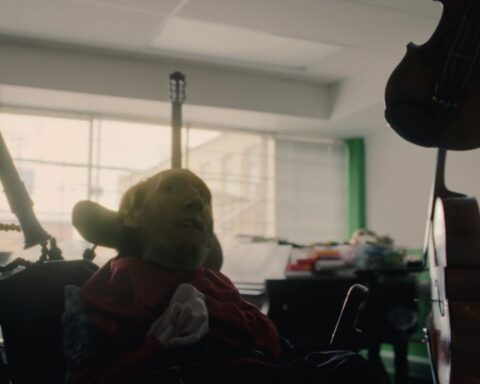Pavarotti
(104 min.)
Dir. Ron Howard
“At first, I was engrossed just by the shape of his journey, this remarkable, nothing-but-high watermarks career, the vast success,” notes director Ron Howard in the press kit for Pavarotti. “But when I looked deeper, I also saw that he bore the brunt of taking so many artistic risks. That drama was unexpected and felt extremely human.”
Howard’s generic statement on the joys of diving into the research on the late opera superstar Luciano Pavarotti reflects what transpires in his documentary. Pavarotti isn’t the work of an adoring fan, nor a work of a filmmaker paying tribute to an artist who inspired him. (Despite picking my brain and consulting IMDb, I couldn’t recall an evocative Pavarotti cue in A Beautiful Mind, Rush, Apollo 13, or any of those Da Vinci Code movies.) Pavarotti is a work-for-hire film, plain and simple, which makes it a bit of a rarity in the world of theatrical documentary, but relatively in tune with Howard’s overall filmography.
However, Howard is Hollywood’s great metteur-en-scène. While he has no signature style or recurring thematic concerns, his films, How the Grinch Stole Christmas notwithstanding, are consistently appealing and handsomely crafted. This film is no exception. Pavarotti is an entertaining and technically accomplished bio-doc that doesn’t frame its subject anew. It’s bound to please opera fans and folks eager for an easygoing matinee with good music.
Pavarotti completes something of a “musical icons” documentary trilogy for Howard after the hit Beatles’ doc Eight Days a Week – The Touring Years (2016) and the Jay-Z flick Made in America (2013). He knows how to put together a good documentary. His deep dive into the research, aided by much of his Eight Days a Week team, uses a wealth of archival materials and interviews to construct an entertaining and humanizing portrait of Pavarotti in cradle-to-grave fashion.
The doc charts Pavarotti’s journey to superstardom beginning from his humble origins growing up in a working class family in Modena, Italy. Howard elucidates Pavarotti’s work ethic and passion for music by showing how he nourished his love for opera by listening to his father’s records and by taking singing lessons while supporting himself with a host of day jobs, including a stint as an elementary school teacher. The film ploughs through the relatively uninteresting chapters of Pavarotti’s early life and cuts to the chase to give viewers what they came for: the voice.
Pavarotti derives much of its success from the tenor’s signature voice. Recordings of his early performances highlight a deep and rich vocal style coming into its own, while film clips of Pavarotti’s initial gigs reveal his magnetic stage presence. The larger-than-life man knows how to command a stage and use his portly frame, jovial demeanour, and powerful voice to bring his characters to life with operatic flair. Interviews with his early collaborators, including his first wife, Adua Veroni, speak of his commitment to his craft and his well-fought rise from supporting player to leading man. Helpful soundbites with Pavarotti’s contemporaries, like American soprano Madelyn Renée and Romanian soprano Angela Gheorghiu, explain the technical elements of the tenor’s voice and its range in the musical scale that makes it so unique. The film’s impressive Dolby Atmos sound design also ensures that audiences get to appreciate Pavarotti’s voice to the fullest.
Howard’s film gives Pavarotti credit for returning opera to its roots as an art form for the masses. The film features conversations with Pavarotti’s changing management team, notably manager Terri Robson, concert impresario Harvey Goldsmith and early American promoter Herb Breslin, who turned the tenor into a rock star. Pavarotti goes deepest with Breslin, who drove hard bargains and created exhausting campaigns that paid off by touring the tenor in regions in America that rarely get to enjoy live opera, culminating in a sold-out show at Madison Square Garden. Howard doesn’t skimp on the juicy bits of American television that shaped Pavarotti into an unlikely icon and the director’s previous experience with “Beatlemania” probably helped in his regard, as Pavarotti has fun drawing out all signatures of the tenor’s star persona, including his insatiable appetite for both pasta and women.
As the film veers through Pavarotti’s career, it spotlights his collaborations with Hungarian entrepreneur Tibor Rudas, who took Luciano’s stardom to even bigger heights with the “Three Tenors.” Pavarotti’s fellow “Three Tenors” José Carreras and Plácido Domingo both appear in new interviews to illuminate the relationship and camaraderie of the musical troupe, while archival footage of their concerts gives audiences a taste of the trio’s lovingly goofy charm. The doc highlights the global appeal of Pavarotti and his music to show how opera can be both high art and accessible mainstream entertainment. However, later glimpses at “Pavarotti and Friends” charity concerts with Sting, Celine Dion, and the Spice Girls might lead one to argue that Pavarotti pushed his art to the level of all-out commercial bastardization even if the efforts were for a number of good causes. An extended episode on his “Christmas in Sarajevo” collaboration with Bono is especially cringe-worthy.
The film consistently puts the tenor’s voice at its centre while creating a portrait of Pavarotti’s life and career. Howard uses an impressive range of material to let Pavarotti speak about his highs and lows in his own voice. However, Pavarotti isn’t Maria by Callas, which similarly uses an archival tapestry to portray soprano Maria Callas and features some truly rare gems that only a fan as adoring as director Tom Volf could doggedly pursue to do the diva justice. What elevates Maria by Callas is Volf’s unabashed adoration for his subject and his desire to make audiences feel the same deep level of appreciation he experiences each time he hears her music. Note the extended arias within Volf’s film as the choice to cut a Callas cue is akin to blasphemy. Howard, on the other hand, adeptly and economically covers a much longer life and career in under two hours, and where Volf uses his archival exercise to say something new and intriguing about Callas, Howard delivers a purely conventional biography. This point isn’t to say that Pavarotti isn’t worthwhile, but rather to show the difference between the work of an auteur and a metteur-en-scène. Perhaps it’s fitting that a film about Luciano Pavarotti seems designed for mass appeal.
Pavarotti opens in theatres beginning June 7.











